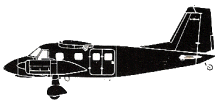Incident Overview

Description
Convair CV-580 LN-PAA was on a charter flight from Oslo-Fornebu (FBU) to Hamburg (HAM). The flight was due to depart at 15:00 hrs. The departure was delayed by almost an hour due to the CAA Norway and the catering company having suspended Partnair?s credit. Once the financial problem was settled the crew was given permission to depart. During the period September 6-8, 1989 LN-PAA experienced some technical problems with the left AC power system. The AC generator was replaced, but the malfunction in the system remained. On the flight to Hamburg it was decided to use the APU generator as the electrical power source for the left AC system. LN-PAA took off at 15:59:50. The flight proceeded normally to the planned cruise level, which was FL220. At 16:04 Flight 394 was cleared direct to AAL VOR/DME (Aalborg). When the aircraft climbed through FL180 at 16:16, the crew was informed by Oslo ACC about strong westerly winds at altitude. The air traffic controller suggested a 101 heading change to the right. At 16:22 Flight 394 was informed that the radar service from Oslo ACC terminated and that the flight would enter Danish-controlled air space in 2 minutes. The flight was then requested to contact Copenhagen ACC. The airplane reached its cruising level at 16:23. Half a minute later the crew established contact with Copenhagen ACC and informed them that PAR 394 was maintaining FL220, whereupon Copenhagen ACC confirmed that they had radar contact. This was the last radio contact with the flight. The flight proceeded normally until about 16:38. Vibrations occurred in the vertical stabilizer. These vibrations developed into violent oscillations or flutter of the horizontal tail surfaces and rudder. Vital parts of the tail section then failed and the crew lost control of the airplane. Both wings failed simultaneously under negative G loads. The Convair fell into the sea. CAUSES: “The accident was caused by loss of control due to the destruction of primary control surfaces in the tail section, which, in turn, was caused by aeroelastic oscillations initiated by abnormal clearances in the vertical stabiliser attachments to the fuselage structure. The condition of the attachments was a result of excessive wear in pins and sleeves used in this structural joint. The pins and sleeves were of an inferior quality and did not satisfy specified values for hardness and tensile strength. They had also been installed and inspected using sub-standard maintenance procedures. Undamped oscillations in the elevator contributed to the structural failure of the empennage.”
Primary Cause
The primary cause of this incident was the catastrophic structural failure resulting from an undamped oscillation of the vertical stabilizer caused by abnormal clearances in the vertical stabilizer attachments to the fuselage structure. This was initiated by excessive wear in pins and sleeves used in this structural joint, leading to inadequate hardness and tensile strength.The primary cause of this incident was the catastrophic structural failure resulting from an undamped oscillation of the vertical stabilizer caused by abnormal clearances in the vertical stabilizer attachments to the fuselage structure. This was initiated by excessive wear in pins and sleeves used in this structural joint, leading to inadequate hardness and tensile strength.Share on:





